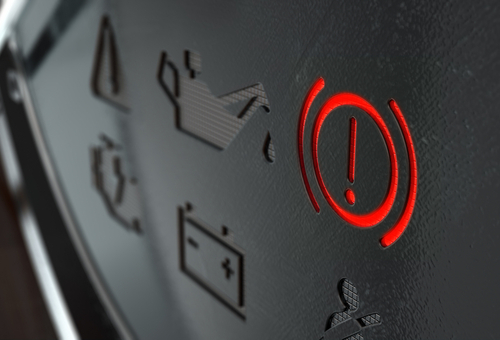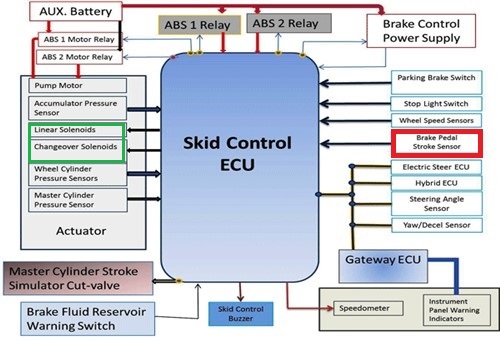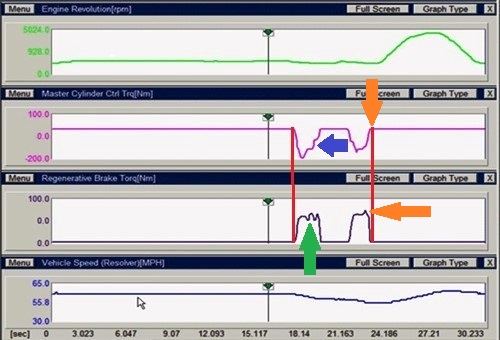
In Part 1 of this series of articles, we discussed regenerative braking systems in general terms to provide some context for a more technical discussion of these systems in this article. In the previous article, we also used the terms “brake-by-wire systems” and “regenerative braking systems” somewhat interchangeably, but note that in the interests of both technical accuracy and conformity, this article will only use the terms “regenerative braking” and “regenerative braking systems”, which begs the question of-
For the purposes of this article, the term “brake-by-wire” refers to conventional hydraulic brake systems that are enhanced by the addition of electronic control systems. While these systems still depend on driver inputs on the brake pedal to work, the pressure a driver applies to the brake pedal is converted into an electrical signal, which signal is used to calculate a brake response that is appropriate to the situation.
As a practical matter, the system measures both the force on the brake pedal and the rate of the pedal's movement to generate an electrical signal that is used by a microprocessor-controlled hydraulic pump to activate the brakes. While these types of brake systems also still use engine vacuum-powered brake boosters, it takes most brake-by-wire hydraulic brake systems only about 100 milliseconds to develop sufficient braking force to activate the ABS function, as opposed to the about 300 milliseconds or so it takes most conventional (un-enhanced) hydraulic brake systems to develop similar braking forces.
Besides, unlike regenerative brake systems that disable ABS and other features such as traction -, and stability control systems under some conditions, brake-by-wire hydraulic brake systems maintain these features throughout all braking events. Moreover, hydraulic brake-by-wire systems are designed to provide a driver with a consistent “pedal feel” and braking response that largely corresponds to the force a driver applies to the brake pedal. Regenerative braking systems, on the other hand, are activated automatically when a driver removes pressure from the accelerator pedal, which brings us to the most common customer complaint about regenerative brake systems, this complaint being-
While having brakes that come into operation automatically sounds like a nice feature to have, the fact is that many drivers of HEV vehicles sometimes experience somewhat disconcerting effects such an inconsistent brake pedal feel, varying brake pedal travel, and fluctuations in the rate of deceleration when the hydraulic brakes are applied when regenerative braking is in operation.
These effects are common to all EV/HEV vehicles, although most OEM manufacturers have made some progress in eliminating and/or reducing these undesirable effects. However, many first-time drivers of an EV or HEV vehicle can be forgiven for thinking that there is something wrong with the brakes on their vehicles if the brake pedal travel varies wildly from one braking event to another.
One other common complaint involves noticeable fluctuations in deceleration under some conditions when both the hydraulic brakes and the regenerative system are in operation. In some cases, the rate of deceleration may increase sharply, while in others, the rate of deceleration may decrease noticeably, even though a steady pressure is maintained on the brake pedal. So what causes these effects, and what do you tell a customer who is complaining about the brakes on his EV/HEV vehicle if there are no brake-related fault codes present?
Well, you could try to explain to your customer that his brake system is working as expected, but it has been this writer’s experience that most customers do not readily accept this explanation. It is, however, true, since many of the undesirable effects some drivers experience are the direct result of both physics and the regulations that describe and/or define the operational and safety aspects of regenerative braking systems. This is quite a mouthful, so let us look at the regulations first, and more specifically, at-
It should be noted that while Regulation 13-H, which forms a part of the United Nations Economic Commission for Europe (UNECE) Regulation for the type-approval of braking systems applies primarily to EV and HEV vehicles manufactured in Europe, manufacturers of EV and HEV vehicles in other markets have largely adopted the general provisions of this regulation. Therefore, and even where slight deviations from the provisions of this regulation exist in vehicles made in markets other than the European Union, the similarities in the technical requirements, test methods and limit values for the braking systems of all EV/HEV passenger cars and light commercial vehicles are sufficiently large for Regulation 13-H to apply to all EV/HEV vehicles regardless of their origin.
However, Regulation 13-H is too long and too complex to discuss here in anything that approaches a comprehensive manner. Therefore, we will only focus on the aspects of this regulation that produce variable brake performance in EV and HEV vehicles, and in particular, how the regulation affects the relationship between regenerative and hydraulic braking.
Before we get to the specifics of Regulation 13-H though, consider the image below-

Image source: https://www.searchautoparts.com/sites/www.searchautoparts.com/files/images/MA0116-UC9-Toyota-Prius-Braking-System.gif
While this image shows the general schematic layout of the regenerative braking system on a late-model Toyota Prius, the same general pattern of this layout also largely applies to the regenerative braking systems of EV/HEV vehicles made by other manufacturers. Note the items in the red square and the green box: the item in the red square measures the force being applied to the brake pedal, and the solenoids in the green box regulate the application of hydraulic braking forces to individual wheels. In combination, these components form the heart of the regenerative braking systems on all EV/HEV vehicles. So what does the above have to do with the regulations? Simply this-
Sections 5.2.7 and 5.2.10 of Regulation 13-H requires that the service brake (hydraulic brake) system be capable of compensating for the loss of regenerative braking in instances where regenerative braking is disconnected or not available, such as when the HV battery pack's SOC exceeds a maximum allowable threshold. One other possible reason for disconnection of the regenerative braking system might be when the vehicle reaches a road speed at which regenerative braking is not possible. However, Regulation 13-H is not clear on whether this requirement must apply when only the regenerative braking system is in operation, or if it must apply if both the regenerative and hydraulic brake systems are in operation.
The problem with this lack of clarity is that the requirement is interpreted differently by different OEM manufacturers, and although all manufacturers of EV/HEV vehicles make some provision for the hydraulic brakes to compensate for the loss or gradual deactivation of the regenerative brake system, both the degree and timing of compensation varies greatly between manufacturers. There is more though-
Section 5.2.10 of Regulation 13-H also states that in cases where only the regenerative braking system is in operation at any given moment and the hydraulic braking system is activated to compensate for the loss of regenerative braking, the hydraulic system must be capable of reaching 75% of its maximum line pressure within one second. Therefore, and in practice, this section does not require that the hydraulic brake system be capable of providing full compensation for the loss of regenerative braking, nor does it specify the maximum allowable amount of time for the hydraulic system to reach 100% of its maximum line pressure.
Again, different manufacturers interpret section 5.2.10 differently, which means that under real-world driving conditions, a driver of an EV/HEV vehicle might experience a disconcerting decline in the rate of deceleration while the hydraulic brakes build pressure to compensate for the loss of regenerative braking. On some vehicles, this could be followed by a steep rise in the rate of deceleration as the hydraulic brakes come online, so to speak, and while this is normal behaviour, many drivers of EV/HEV vehicles find the resulting inconsistent braking performance unsettling and uncomfortable, if not downright frightening.
However, there is a way to check if the compensation period is excessive or not. Consider the image below-

Image source: https://www.searchautoparts.com/sites/www.searchautoparts.com/files/images/MA0116-UC13-Lexus-Scan-Tool-PIDs-Regen-Braking.gif
These scope traces were taken at the same time on a Toyota Lexus hybrid, and collectively, they represent two sharply defined braking events that are delineated by the two vertical red lines. The green trace at the top represents the engine speed, while the bottom trace represents vehicle road speed. Let us look at the second (from the top) trace first-
This trace represents the line pressure in the hydraulic brake system, as measured at the master cylinder when pressure was applied to the brake pedal. While the upward sloping ramp indicated by the blue arrow might be interpreted as a reduction of force on the brake pedal, the reduction in line pressure was in fact caused by various control modules that reduced line pressure in the hydraulic system as the regenerative braking effect increased.
The next trace down represents regenerative braking force, here shown as the strength of the magnetic field(s) in the motor/generator's field coils. Note the rapid increase in field strength and the small variations in the plateau of this waveform. The small bumps could be caused by changes in the battery's SOC, or by imperfections in the motor/generator’s field coil windings, or more likely, by minor imbalances between battery cells and/or battery blocks. Either way, the bumps are not big enough to cause concern; what is important here is that the braking effects of the two braking systems match each other perfectly, as would be expected on a high-end application on which both brake systems are in perfect working condition.
In this example, the vehicles’ drive wheels are capable of producing 85% of the vehicle’s total brake force, but in this particular braking event, the regenerative braking system operated at 100%, as can be seen at the points indicated by the orange arrows. In the second trace, hydraulic line pressure drops to zero, while in the third trace, the orange arrow indicates the regenerative braking systems’ magnetic field at 100% of its rated strength, which brings us to-
There is, sadly, a steep learning curve involved in learning to decode traces like these, but the primary object of obtaining traces like these is not always to diagnose faults. The primary objective is often to see if there is a discernible lag between when the regenerative braking system activates, and when the hydraulic braking system comes online when the force on the brake pedal exceeds about 20N.
While lags of up to one second are acceptable, and particularly on high-mileage vehicles, it can sometimes be extremely challenging to diagnose the cause of excessive lags. Part of the reason for this is the lack of OEM service information, and although relevant service information can be had, it unfortunately comes at the price of a subscription.
The other part of why it is sometimes challenging to diagnose faults on regenerative braking systems is that it is very easy to overthink problems. It has been this writer's experience that many technicians forget that EV/HEV vehicles also have hydraulic brake systems and that on a practical level, these hydraulic systems are for the most part, almost identical to the hydraulic brake systems on conventional vehicles. In practice, over thinking issues often cause technicians to look for faults in, for instance, communications systems, when the root cause of the problem might be no more complicated than glazed brake pads and/or corroded brake rotors.
Moreover, since the hydraulic brake systems on EV/HEV vehicles that are used primarily in urban driving conditions hardly ever work at more than a few per cent of their rated capacity, issues like sticky, frozen, corroded or even seized callipers are far more common on EV/HEV vehicles that on conventional vehicles.
Also, since hydraulic brake systems on EV/HEV vehicles are among the most commonly overlooked items during scheduled services or routine maintenance procedures degraded brake fluid is among the leading causes of brake failures and/or issues on EV/HEV vehicles. This writer has fixed many regenerative braking system issues on hybrid vehicles simply by replacing the brake fluid, or by stripping down, and lubricating sticky/binding brake callipers to allow them to move freely.
Other common causes of degraded brake performance involve damaged and/or degraded HV battery packs. While most HV battery faults will set fault codes and/or illuminate one or more warning lights, many drivers of EV/HEV vehicles choose to ignore these warnings for reasons that are not always clear.
Nonetheless, customers can generally be forgiven for not knowing that all regenerative braking systems are designed so that the amount of energy recovered during a braking event does not exceed the maximum amount of charge current an HV battery pack can accept. In practice, this means that if an HV battery pack is near its maximum SOC, the level of regenerative braking that takes place will be proportional to the current the battery can accept. Therefore, to ensure that regenerative braking is not compromised or reduced by a high battery SOC, most EV/HEV vehicles make use of ultra-high capacity capacitors to accept and store the recovered energy.
On the other hand, if the HV battery pack’s SOC is low, but the battery is otherwise in good condition, almost all of the energy that is recovered during regenerative braking will be accepted by the HV battery, which translates into high regenerative braking forces. However, if the HV battery is damaged or not balanced, or one or more of high capacity capacitors are not functioning optimally, one or more control modules will limit the amount of recovered energy to what either or both the battery and/or capacitors will accept, which usually manifests as degraded/reduced overall braking performance, which brings us to-
Unfortunately, limited space precludes a more detailed discussion of regenerative braking system diagnostics, but if this writer can offer one more piece of general advice, it would be this-
Do not overthink problems and/or symptoms, and start with checking /inspecting the simplest and most obvious causes of degraded braking performance first. This usually involves performing a comprehensive diagnostic scan of all control modules, followed by gathering as much information as is available on both the SOC and SOH of the HV battery pack, since many issues with regenerative braking systems start with the condition of the HV battery.
This should be followed by a thorough visual inspection of the hydraulic brake system, paying particular attention to the condition of both the brake rotors and the brake pads. Look for signs of overheating and/or glazing of friction surfaces, which is common. This happens primarily because hydraulic brake components rarely reach the temperature at which they work optimally, so replace all suspect components (including brake fluid) with OEM parts, or with aftermarket parts that were designed specifically for use on EV/ HEV vehicles to ensure proper operation of the hydraulic brakes.
Note though that while the above might appear to be self-evident to most experience technicians, procedures such as replacing brake pads and/or bleeding hydraulic brake systems on EV/HEV vehicles must not be attempted without making proper reference to OEM service information, and using factory-level scan tools and software.
For instance, the simple act of applying (hydraulic) brake pressure for the first time after completing these kinds of procedures can generate multiple fault codes, none of which can be cleared with generic scan tools. Therefore, you need to ensure that you have suitable scan tools and software ready at hand before you attempt to diagnose and repair regenerative brake system issues, which leaves us with this-
While the complexity of regenerative braking systems can appear to be daunting, if not intimidating if you have never dealt with them before, the fact is that these systems are based on well-established principles of electricity and magnetism. Therefore, the process of creating a regenerative braking force follows clearly defined pathways in the electrical systems of EV/HEV vehicles, and if you are familiar with the basic laws of electricity, the process of identifying breaks in the system's pathways becomes a whole lot easier.
Of course, knowing about Regulation 13-H and what it says and does not say, also helps, since knowing what it does not say can often prevent you from falling into a diagnostic rabbit hole.